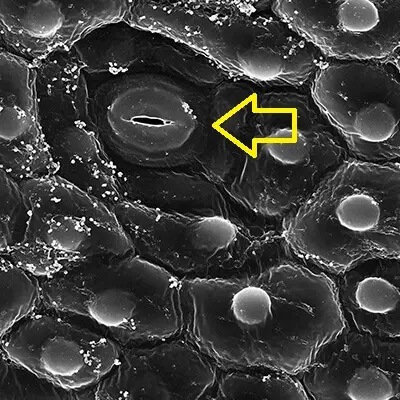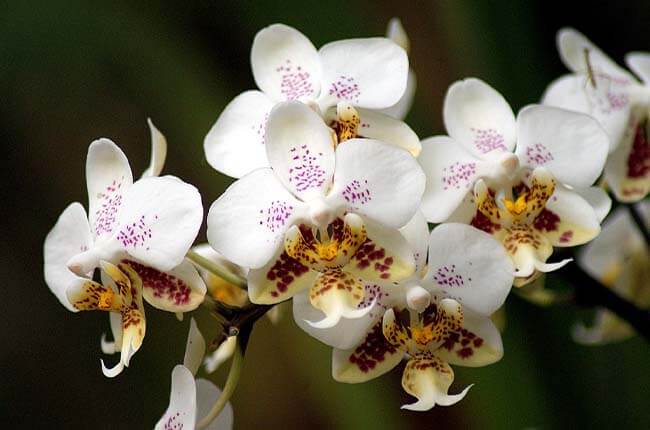Foliar feeding is not a myth if you do it right. It involves applying water-based fertilizers to the undersides of the orchid leaves.
Orchids can absorb micro-nutrients through leaves, mostly at night when the pores or stomata on the underside of leaves are open. Micro-nutrients can enhance growth and blooming and are best fed through the leaves, rather than roots, as they cannot be transported efficiently from the roots.
This article aims to explain how orchids absorb nutrients, the correct way to apply foliar fertilizers, and review some popular foliar spray products.
How does foliar feeding work for orchids?
Studies have found that liquid nutrients can enter leaves through thousands of microscopic pores, called “stomata” (singular: “stoma”), on the surfaces of leaves.
Each stoma, about 20 micrometers wide, is flanked by two guard cells responsible for the opening and closing of the stoma to allow the exchange of carbon dioxide and oxygen in and out of the leaf.

(Lauren Holden. Attribution 4.0 International, CC BY 4.0)
In the case of most orchids that have thick leaves such as Phalaenopsis, Vanda, and Cattleya, stomata are only found on the undersides of orchid leaves. The top surfaces of orchid leaves do not have any stomata and are covered by a thick waxy cuticle to retain water in order to survive arid conditions. These orchids open their stomata only at night, just like cacti and other arid climate plants, to acquire carbon dioxide and store it inside the plant for photosynthesis later when there is light. This process is called Crassulacean Acid Metabolism or CAM.
A small number of orchids that have thinner leaves, such as Dendrobium, Cynbidium, Dracula, open their stomata during the daytime to perform photosynthesis using the C3 pathway. They also have a higher density of stomata.
Apart from the water retention design, orchid leaves have been shown to be able to absorb nutrients in liquid form through the stomata. A study showed that almost 35% of the fertilizer sprayed was found 24 hours later inside the plant below the leaf that had been sprayed (Sheehnan et al., 1967).
Why you should foliar feed orchids?
Absorbing nutrients through leaves, or foliar feeding, not only works for orchids. It is, in fact, more efficient than root feeding orchids when it comes to the uptake of micronutrients (zinc, manganese, iron, copper, boron and molybdenum) that are generally immobile in the phloem (stem) and cannot be transferred efficiently from the roots to other parts.
A study showed a 95% efficiency of nutrient use by the plant when fertilized through leaves, compared with a 10% efficiency of nutrient use when fertilized through roots.
Micronutrients are needed in small amounts but are important for photosynthesis and the growth of orchids. They are important for nutrient deficiency.
Macro-nutrients (e.g. nitrogen, phosphorus, potassium) on the other hand are best applied to the roots because they are needed in large quantities. If applied to leaves, they would be burnt by the high concentration of fertilizers. Here is an article about the nutritional needs of orchids.
Therefore, both foliar feeding and root fertilization are crucial in meeting the nutritional needs of an orchid.
How to spray fertilizers on orchids?
Foliar feed needs to be applied correctly to increase the absorption of nutrients. Below is the advice from expert orchid growers.
- Foliar feeds should be applied after watering.
- It should be done during the stomata opening hours, at night or in the cooler morning hours. Fertilizing during the cooler morning hours is preferred to prevent water standing on the leaves all night which would lead to crown rot. If done indoors, care must be taken to keep the crown dry and not leave any standing water on the leaf surfaces.
- To assist the fertilizer to adhere to the leaves, add a surface tension-reducing agent, such as 1 to 2 drops of detergent or liquid soap, to 1 gallon (3.8 liters) of foliar fertilizer.
- Use a fogger to create a fine aerosol-sized mist, which is preferable to large droplets because of greater leaf contact for better absorption. But, remember to use personal protective gear including a respirator to prevent breathing in the fine mist of chemicals. If you don’t have the equipment, use a spray bottle.
- It is best to start a fertilization routine of both the roots and foliage starting in spring when orchids start actively growing due to longer days and higher temperatures. It is recommended to feed a weak solution once or even twice a week in spring and summer with maximum growth, then reduce it to half the frequency in fall or discontinued in winter.
- Owner of Gold Country Orchids, Alan Koch, follows a 5-week fertilization routine that is repeated throughout the year. In the first week, a balanced macronutrient fertilizer is applied to the root zone. In the second week, a fertilizer with micro-nutrients is applied to the foliage. In the third week, the same macronutrient fertilizer is applied again to the root zone. In the fourth week, the foliage micronutrient fertilizer together with seaweed and kelp are applied. In the fifth week, the pot is flushed with water to eliminate any salts accumulated in the roots.
- Finally, test the method on one or two leaves of an orchid, before applying it on all your orchids.
Best foliar fertilizer for orchids
Due to the growing popularity of foliar fertilizers, there are many brands out on the market.
My favorite is Cal-Mag fertilizer by Bloom City

The reasons are:
- Compared with other brands, this product contains more micronutrients which are important to prevent growth deficiencies. Apart from the major ingredients Calcium (2%), Magnesium (0.6%) and Nitrate Nitrogen (2%), it contains trace minerals, namely Boron (0.002%), Copper (0.003%), Iron (0.004%), Manganese (0.004%), Zinc (0.004%).
- This 32oz product offers the most bang for your buck for a Cal-Mag supplement as it can be diluted in many gallons of water. For example, in the growth phase in spring, dilute only 2.4ml of the Cal-Mag fertilizer per gallon of water. In the blooming phase, dilute 3-6ml of the fertilizer per gallon of water.
- This product is made in the USA, uses organic chelates and doesn’t contain harmful chemicals like EDTA, unlike other brands.
Another popular foliar feed product is “Orchid Plant Food Mist” by Miracle-Gro.

- The good thing about this product is that it is ready to use, meaning you don’t need to hassle with mixing and diluting it with water. This is convenient, especially for people who grow their orchid(s) in the office.
- Also, it comes in a spray bottle which can produce a very fine mist that helps absorption.
- But, I would not recommend this product to most orchid growers and enthusiasts because it comes in a small 8 oz (236ml) bottle which can last only 3-6 months for 1 orchid. This is okay if you have only 1 or 2 orchids, but not for many of us who have a collection of orchids to feed.
- It’s expensive for the small amount of fertilizer you get. Compared to other brands such as Bloom City recommended above, you don’t get much of a bang for your buck with this product.
Conclusion
Foliar feeding is an excellent way of feeding micronutrients to orchids. It is crucial for photosynthesis and plant growth, and cannot be replaced by root fertilization. But, it is best done outdoors and should be applied correctly on the undersides of the orchid leaves in the early morning hours and best in a fine mist.
When done correctly, your orchids would receive a flower boost that only outstanding growers can achieve!
Happy gardening!
Related
Top 10 Orchid Fertilizers: A Detailed Review
Orchid Nutrient Deficiency: Symptoms & Solutions (Pictures)
References
Koch, Alan. My Addiction to Miniature. The American Orchid Society. Orchids, 76(6), 426-435. https://www.aos.org/AOS/media/Content-Images/PDFs/MiniCatts.pdf
Pettinelli, Dawn. Foliar Fertilization. University of Connecticut Soil Nutrient Analysis Laboratory. https://soiltest.uconn.edu/factsheets/FoliarFertilization.pdf
Grossmann, Janette (1997). Foliar fertilization of orchids. Department of Horticultural Sciences, Texas A&M University, pp. 38-43. http://cochran.agrilife.org/files/2011/09/plant-nutrition.pdf#page=43
- Top 6 Drip Irrigation Systems for Raised Beds (2025) - January 31, 2025
- Top 10 Orchid Fertilizers: A Comprehensive Review (2025) - January 16, 2025
- Top 6 Slow-Release Fertilizers for Houseplants & Veggies (2025) - January 15, 2025

